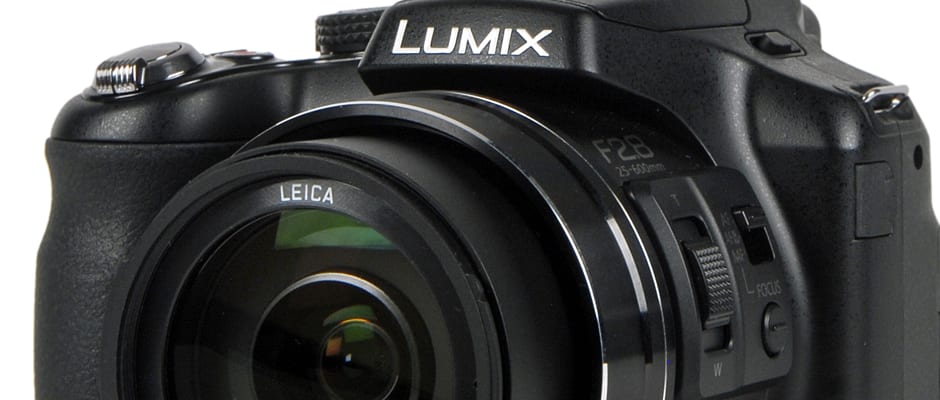Pros
Cons
Introduction
Most of the vital specs are held over from last year's excellent FZ150 superzoom—still the top-scoring fixed-lens camera on DigitalCameraInfo.com—including a 24x zoom range, an articulating 3-inch LCD, manual exposure control, RAW capture, and 12fps burst shooting.
We got some hands-on time with the FZ200 at a press briefing last month. Read on for our first impressions. Pricing and launch date haven't officially been announced, but Panasonic tells us that the FZ200 will debut at $599—up $100 from the FZ150's original launch price—and will be available in black.
Design & Appearance
{{section_header}}{{section.name}}{{/section_header}}
Simply put, the FZ200 looks like a Panasonic FZ-series superzoom. If you've seen one at any point in the past five years or so, you'll know what to expect. It's designed to look like a serious system camera, even though it has more in common with a point-and-shoot than a DSLR.
The FZ200 is actually larger than last year's FZ150, mainly because the constant f/2.8 lens is bulkier than last year's lens, which had a tapering aperture. On the whole, it's still very similar to its predecessor, and not much different than most superzooms in general.
Tour
{{section_header}}{{section.name}}{{/section_header}}




Menu
{{section_header}}{{section.name}}{{/section_header}}
The main menu here got a bit of a facelift. The background is no longer plain white (now it's a soft blue), and the text looks a little crisper. But functionally, it's the same as previous higher-end compact models. The menu options are laid out logically, though not so much for quick changes.
With the quick menu system, several hot keys and 3 assignable Fn buttons, you probably won't spend too much time in the main menu system anyhow. The quick menu system (counting the individual setting menus, via hot key or Fn button) is nimble, —much better for making adjustments to common parameters like ISO, white balance, and the like—and largely unchanged from previous models.
Ease of Use
{{section_header}}{{section.name}}{{/section_header}}
Like most fixed-lens cameras, the FZ200 can be left in auto mode and used by just about anybody with solid results, prior experience or not. But as the extra shooting modes and buttons suggest, this camera is built for photographers who like to do some of the work themselves.
In our brief time with the FZ200, it worked like the other Panasonic superzooms we've used over the past few years. Manual control isn't quite as intuitive as it is with a system camera, or at least a camera with a few more hot keys and two jog dials. But it's close enough for most serious photographers to feel comfortable tinkering with settings.


Size & Handling
{{section_header}}{{section.name}}{{/section_header}}
When we handled the FZ200, it felt a little bit bigger and heavier than the average superzoom, though that might've been the power of suggestion—Panasonic's reps were upfront with the fact that the FZ200 is bigger than the FZ150 because of the constant f/2.8 aperture.
The grip is nice and large, and it's still light enough to hold with one hand. It's not too far off from the new Panasonic G5 (with its kit lens) but considerably smaller than a traditional DSLR and the Fuji X-S1 superzoom. Either way, it's too bulky to fit into any kind of pocket. This is a shoulder-strap kind of camera.


Modes Overview
{{section_header}}{{section.name}}{{/section_header}}
The FZ200 has a standard mix of automatic and manual modes, including iAuto, program, shutter priority, aperture priority, manual exposure, 18 scene presets, 14 effects, two custom settings, and 1080/60p movie mode (with full manual control).

Auto Mode
{{section_header}}{{section.name}}{{/section_header}}

Drive/Burst Mode
{{section_header}}{{section.name}}{{/section_header}}
Like the FZ150 before it, the FZ200 tops out at an impressive 12 frames per second of continuous shooting. That makes it one of the fastest cameras of any type based on pure burst speed. With autofocus, it's about half as fast, but that's still impressive.
Playback Mode
Picture Quality & Size Options
{{section_header}}{{section.name}}{{/section_header}}
Resolution tops out at 12.1 megapixels in a 4:3 aspect ratio. It can also shoot in 16:9, 1:1, and 3:2 configurations at a few different sizes. The FZ200 supports RAW and RAW+JPEG capture, with two levels of JPEG compression (Fine and Normal).
Focus
{{section_header}}{{section.name}}{{/section_header}}
It's probably just marketing, but Panasonic claims they've brought over the Light Speed Autofocus system from their G-series lineup. In any case, it's fast. Manual focus is also supported.
ISO
{{section_header}}{{section.name}}{{/section_header}}
Native sensitivity ranges from ISO 100 to 3200. ISO 6400 is available as an extended setting. It's adjustable in whole steps or in steps of 1/3 EV.
Image Stabilization
{{section_header}}{{section.name}}{{/section_header}}
The FZ200 features Power O.I.S. stabilization. It was effective for stabilizing telephoto shots in last year's model, so with a brighter aperture, it should get the job done just fine this time around.
Picture Effects
{{section_header}}{{section.name}}{{/section_header}}
14 picture effects are available in Creative Control mode (as Panasonic calls it), including Soft Focus, Dynamic Monochrome, Impressive Art, One Point Color, Cross Process, Low Key, Toy Effect, Star Filter, Expressive, Retro, High Key, Sepia, High Dynamic, Miniature Effect.
Lens & Sensor
{{section_header}}{{section.name}}{{/section_header}}
Lens
The FZ200 is the third top-end Panasonic superzoom in a row with a 24x zoom lens. That's well behind the 30x, 35x, and 42x models found on most competitors. But the FZ200 has something that they don't—a constant, bright aperture throughout the focal range.
Most superzooms start with a maximum aperture of f/2.8 or f/3.3 at the wide angle before tapering off to f/5.9 or so at the telephoto setting (zoom lenses in general tend to follow a similar pattern). Less light gets through the lens when it's zoomed in, so in situations where light is precious—indoors, for example—it's harder to get a good shot. Photos might be shaky because the shutter needs to stay open for too long, or too grainy because the sensitivity gets bumped up too high.
But the FZ200 is just as bright at the wide-angle (25mm) as it is at the telephoto setting (600mm). When it comes to compact camera lenses, we usually think of f/2 and below as the cutoff for quote-unquote "brightness," but f/2.8 is still pretty good, especially for such a long zoom lens.
Sensor
At the heart of last year's FZ150 was an excellent sensor. On paper, the FZ200's chip is similar—a 12.1-megapixel, 1/2.3-inch MOS sensor—but Panasonic says that it isn't the same one. This concerns us, because Panasonic has been hit or miss with new MOS sensors these past few years.
The FZ100 from 2010 was a big letdown because of its noisy sensor (ditto with the ZS10 compact zoom). And despite the overwhelming success of the FZ150 last year, Panasonic equipped this year's ZS20 compact zoom with another sensor for some mysterious reason, and that camera came up short, too. Ironically, the lower-end ZS15 got the FZ150's sensor and has better image quality as a result.
So the sensor is the wild card here, and we hope for the best.

LCD & Viewfinder
{{section_header}}{{section.name}}{{/section_header}}
Like the FZ150, the FZ200 has a 3-inch articulating LCD with 460,000 pixels of resolution. It's a decent screen, not quite as crisp as the displays on Sony and Nikon superzooms, but it gets the job done.

The FZ200 has a small electronic viewfinder with 1,312,000 pixels of resolution. Our initial impression of the EVF is generally positive. The resolution is pretty high, though we tried out the camera side-by-side with the G5, and the G5's finder looked smoother. The FZ200 has no eye-level sensor, but there is a diopter adjustment dial.

Flash
{{section_header}}{{section.name}}{{/section_header}}
A flash pops up from the top of the FZ200, controlled by a release on the left side of the camera's crest. It's effective out to 13.5 meters—pretty good for a built-in flash.

Jacks, Ports & Plugs
{{section_header}}{{section.name}}{{/section_header}}
As usual, the FZ200 has USB and mini-HDMI jacks, as well as a microphone input.


Battery
{{section_header}}{{section.name}}{{/section_header}}
The rechargeable lithium-ion battery is rated for 540 shots per charge. That's fantastic by compact-camera standards.

Memory
{{section_header}}{{section.name}}{{/section_header}}
Spoiler alert: The FZ200 records to SD/SDHC/SDXC cards.

Other Hardware
{{section_header}}{{section.name}}{{/section_header}}
A hot-shoe accessory port sits on the top of the FZ200.
Conclusion
Big zooms are easy to market, because the advantages are easy to understand: Faraway things look close. So it's obvious why camera manufacturers keep increasing zoom ranges, and for the most part, it's a good thing for the consumer.
Panasonic wants to start a new conversation though. The FZ200 "only" has a 24x zoom lens, far behind the 30x, 35x, and even 42x lenses that their competitors have released, and it's the third year that Panasonic's top-tier superzoom has been stuck at that length. Basically, they've given up on chasing the long-zoom title, and along with that, trying to impress the casual camera buyer.
Instead, they're making a superzoom for enthusiasts. The zoom on the FZ200 is still pretty long—topping out at 600mm—and the f/2.8 constant aperture makes that entire range useful in more situations, not just bright, outdoor lighting. It's one of just a few superzooms with RAW capture, and it has one of the fastest burst modes of any camera, period.
At $599, the FZ200 is more expensive than most other superzooms, but it's a good bet that the kind of serious photographers that can see the benefit of its feature set are willing to spend a bit more. It's a similar strategy that Fujifilm tried with the X-S1, a solid performer.
The wild card is image quality, which has been hit or miss with Panasonic over the past few years. Last year's FZ150 was a phenomenal performer—it's still our top fixed-lens camera, almost a year after we tested it. But the FZ100 before it was a hot mess, and the new ZS20 compact zoom slipped backward as well. With the FZ200, Panasonic once again changed up the sensor—still a 12-megapixel, 1/2.3-inch MOS chip like the FZ150, but apparently it's a different model.
It's cool to see Panasonic take a road less traveled in a category with an obvious path to recognition. We're excited to get the FZ200 into our labs for some proper testing.
{{product.vanity}}
Sample Photos
{{section_header}}{{section.name}}{{/section_header}}
Specs
{{manufacturer_specs_table}}
Meet the tester
Liam manages features and news coverage for Reviewed.com. Formerly the editor of the DigitalAdvisor network, he's covered cameras, TVs, personal electronics, and (recently) appliances. He's a native Bostonian and has played in metal bands you've never heard of.
Checking our work.
Our team is here to help you buy the best stuff and love what you own. Our writers, editors, and experts obsess over the products we cover to make sure you're confident and satisfied. Have a different opinion about something we recommend? Email us and we'll compare notes.
Shoot us an email


